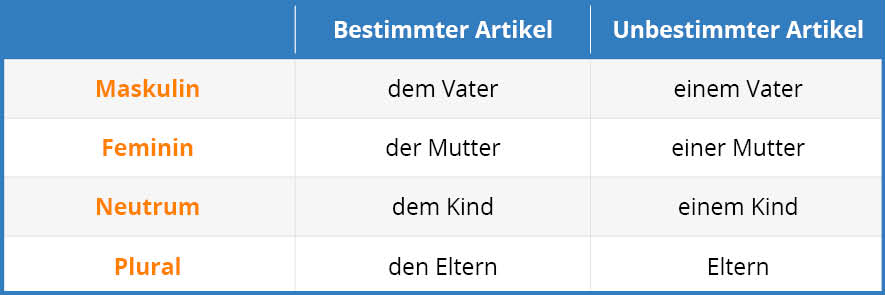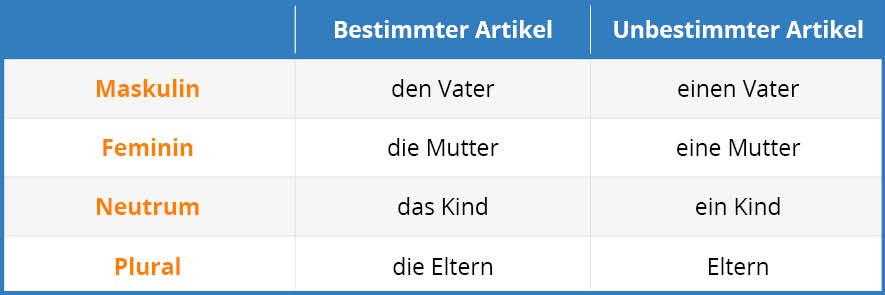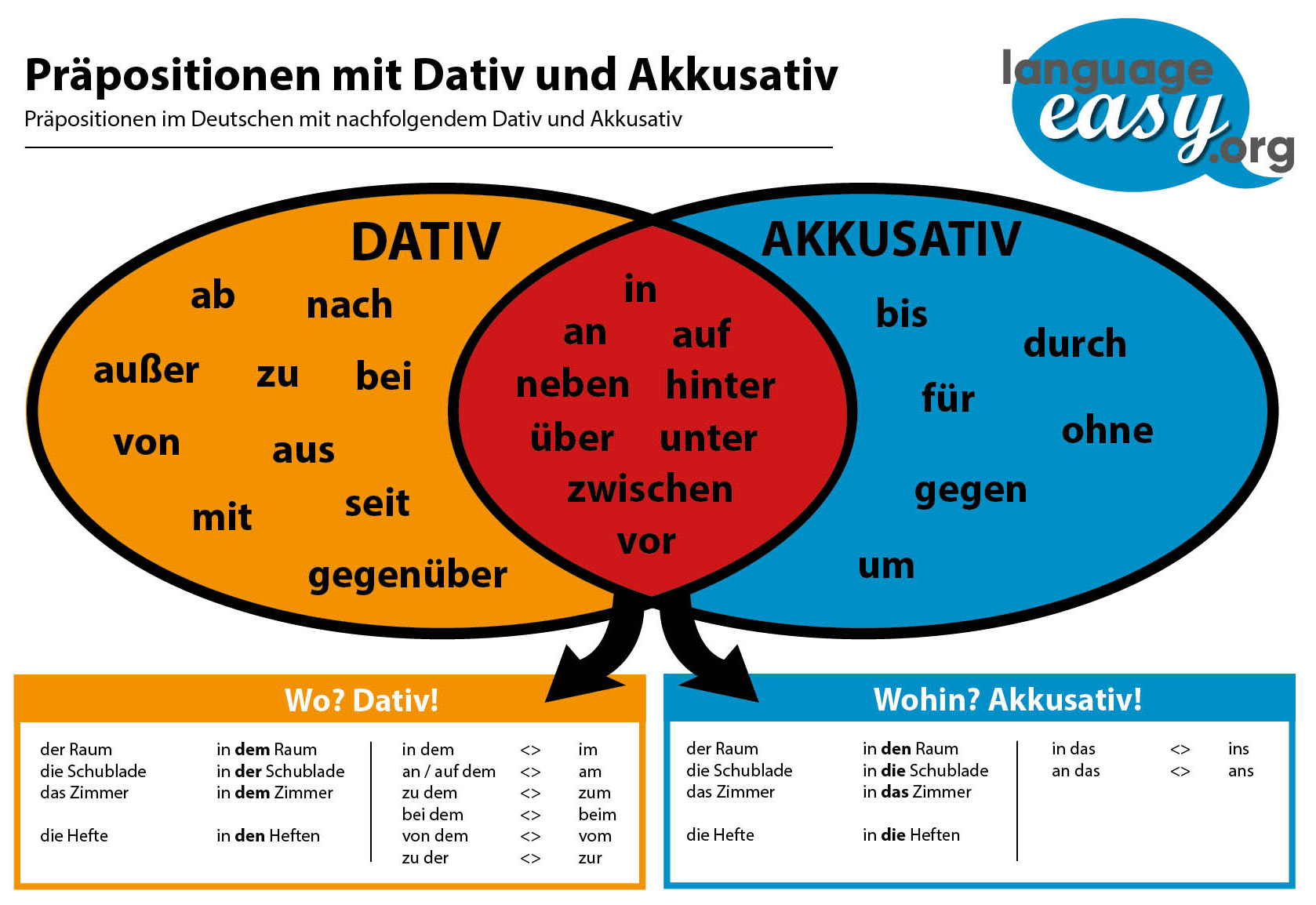German Cases
Die vier Fälle im Deutschen – Erklärungen und Beispiele
German Cases – Summary
Zusammenfassung
Nominative
In most cases, a noun is in the nominative case when it’s the subject of a sentence. The question you ask to determine the subject of a sentence is “Wer?” (Who?) for people and “Was?” (What?) for things. So, it is “Wer oder was?”.
So, in German, you use the nominative case for nouns…
- … which are the subject of a sentence,
- … in the predicative nominative.

Genitive
A noun is expressed in the second case, the genitive, when it is used as attribute for another noun or when it indicates possesion. The German question you would ask to determine the genitive is “Wessen?” (Whose?).
The genitive is applied in the following cases:
- indicating possession,
- in the context of certain prepositions like “während, anstelle, trotz, …”,
- in the context of certain verbs which come with a genitive object,
- with some adjectives.

Dative
A noun is expressed in the third case, the dative, when it forms part of the predicate of the sentences in the sense of an indirect object. The question you ask to determine the dative is “Wem oder was?”.
The dative is applied in the following contexts:
- after particular verbs (dative object), for example “gehören, helfen, antworten”,
- after particular prepositions, like “aus, bei, bis zu, gegenüber, mit, nach, seit, von, zu”,
- as indirect object in sentences with more than one object.

Accusative
A noun is in the fourth case, the accusative, when it refers to the direct object of the sentence, for which one asks “Wen oder was?“. You use the accusative case in the following situations:
- after particular verbs as accusative object, for example “haben, singen, spielen, komponieren, …“,
- after certain prepositions like “durch, für, gegen, ohne, um“.
- for nouns used as direct object in a sentence with more than one object.

Well, is your pronunciation of German good? Do you master word order? Incredible long German compound nouns don’t frighten you anymore? If your answer is yes, I am really impressed. But I have to remember you, that you are learning German. And that means more and more exceptions and rules – there is still a long way to glory!
Nevertheless, you have reached a crucial topic of the German language: German cases! In order to glance in conversation or written messages, you necessarily have to master grammatical cases. So, as you have chosen language-easy.org, you don’t have to worry anymore. Together we will learn how to get German sentences together easily, talk again about prepositions and also about direct and indirect objects. So, without further explanations, let’s just start right ahead with German cases, their explanation, and some examples!
The four German Cases
Die vier Fälle im Deutschen
Unfortunately, we are going to start with the worst but also the most important part of this article and directly explain the four cases in German. First of all, I want to define, what a case actually is. After that, we are going to structure and explain German cases.
So, what is a German case? You could see it as a special category in German grammar, consisting of nouns, pronouns, adjectives, participles, and numerals which have a certain form that determines their function in a sentence.
Pretty dry, huh?
Actually, the most important facts are that we have four German cases:
- Nominative
- Genitive
- Dative
- Accusative
And that these German cases are responsible for the endings of adjectives, indefinite articles and when to use which personal pronoun. So, let’s have a closer look on each one of our four German cases below.
The Nominative Case
So, this is the first one of German cases, the nominative case. This German case is used for a person, for an animal or for a thing doing an action. Usually, you ask the question…
Who (or what) did or is something?
Also, remember that the nominative case is always used after the verbs “sein” (to be) and “werden” (to be). Well, here are some examples for the nominative case with the nouns “der Hund” (the dog), “die Katze” (the cat), “das Pferd” (the horse).

As you could see in this table, the nominative case does not necessarily change the indefinite article. But you will see later on how German cases have their influence on this part.
So, here are some example sentences to illustrate this German case.
- Der Hund bellt. – (The dog barks.) → Who barks?
- Die Katze läuft. – (The cat runs.) → Who runs?
- das Pferd isst. – (The horse eats.) → Who eats?
Ladies and Gentleman, let’s go on to a little more complicated one of German cases, the genitive.
The Genitive Case
Now, we will learn the genitive case. It is not used as frequently as the other German cases, but of course, it is still of high importance. Well, it expresses the possession or expressed in an easier way: It stands for the “of…” or “‘s” in English. For this German case, you have to use the question…
Whose is it?
So, here is a table to show you the influence of the genitive case on definite and indefinite articles of a different gender. Now you will see that genitive changes the word endings much more than the nominative case.

In this case, you can note clearly the changes of word endings: Masculine and neuter take an “s” at the end, whereas feminine and plural don’t take any “s” as an ending. So, let’s come to the next one of German cases, the dative case.
The Dative Case
Unfortunately, it is getting quite serious right now. The dative case is really important because it is used very frequently in every-day language, spoken or written. Furthermore, it changed the word endings in all three genders and in the plural forms. But first of all, let’s clear up what the dative actually is: In English, you could compare it to the indirect object, so the receiver of the direct object. But in the following table, you will see how the dative actually works.
To whom or for whom is this being done?
This is the question you should ask yourself when examining a sentence, looking for the dative case.

Usually, the equivalent of the dative case in English would include “to”, like our example above. Now, let’s see the use of this German case in some example sentences.
- Ich geben dem Hund einen Knochen.
– (I give a bone to the dog.) - Ich gebe der Katze ein Speilzeug.
– (I give a toy to the cat.) - Ich geben dem Pferd ein Brot.
– (I give a bread to the horse.)
Finally, we are going to have a close look at another very important German case, the accusative case.
The Accusative Case
Last but not least, we are going to talk about another important one of German cases, the accusative. So, the accusative is used for the direct object of a sentence. The direct object is a person, animal or thing the action of the sentence is happening to or being acted upon. The question you would ask in order to find this German case in a sentence is…
Whom or what?
In the following table, let’s have a closer look to the word endings. You will see how they change when being used for the accusative case.

As you can see, the word endings in feminine and neuter don’t change at all, whereas the word ending of masculine already changes in the singular form.
Well, as you might have noticed, it is quite hard to understand the differences between dative and accusative in German. Especially for non-German speakers, the questions you ask in order to find out the case, don’t make any sense.
So, focusing on the accusative and dative, there are three ways to find out the differences between these two cases. First of all, there are verb lists that show you which case is connected with each verb. Second, you should learn which case is followed which preposition – something you can observe in the picture of this article. Finally, you can ask yourself the question “Wo?” (Where?) – which is always followed by dative, and “Wohin?” (Where to?) – always followed by accusative as it is an of movement.

German Dative and Akkusative
Some Links and Exercises
Einige Links und Übungen
Don’t be sad – I have to tell you that we have come to the end of our small tutorial about German cases. As you could see, German cases are no big deal, as long as you remember to ask the right questions and learn by heart the articles you have to use in one of the German cases. Nevertheless, it’s still hard work and I hope I could help you a little bit in your studies by explaining the basics of German cases. I want you to show a few useful Links and some exercises.
First, you can do some practice about the articles with the following apps: Der die das (Iphone) and Der die das (Android)
In the following, you will see some phrases that you should complete with the correct terms. Once you have filled all the gaps, just click on the “correct” button and you can see your errors and the correct results. Good luck and .. auf Wiedersehen!



